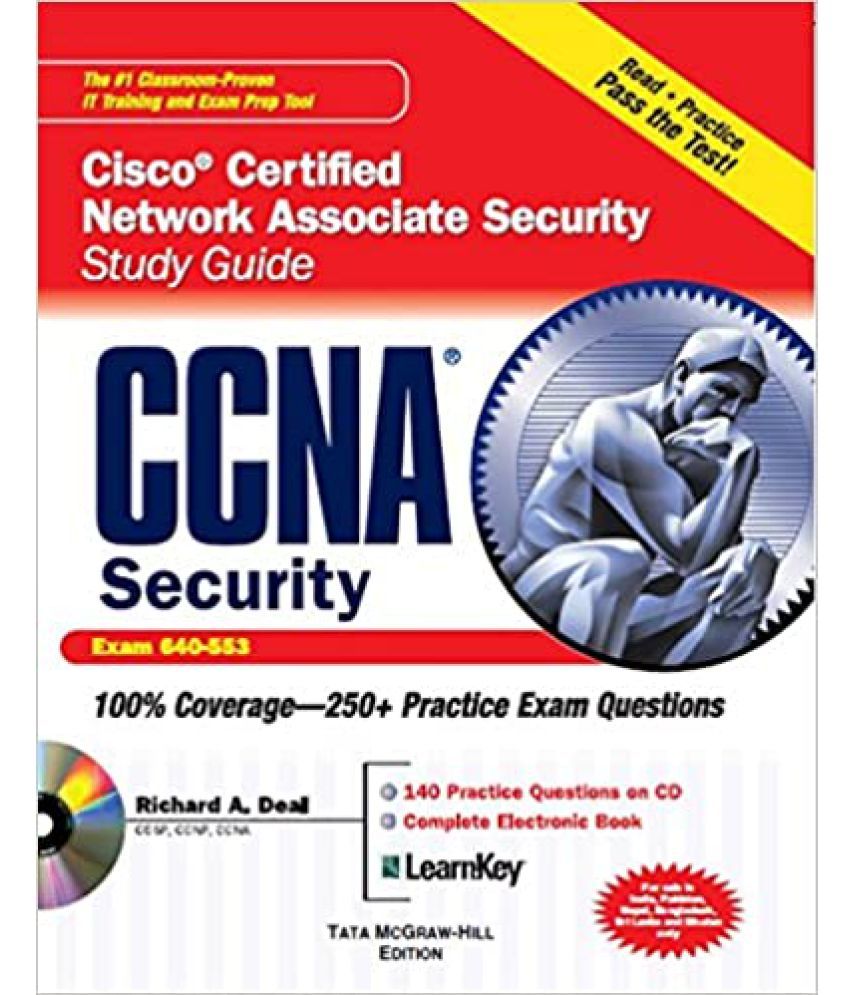- Ccna Cisco Training
- Ccna Cisco Certified Network Associate
- Ccna Video Linkscisco Certified Network Associate Programs
- Cisco Certified Ccna Network Security
- Cisco Certified Network Associate Training
The CCNA certification (Cisco Certified Network Associate) indicates a foundation in and apprentice knowledge of networking. CCNA certified professionals can install, configure and operate LAN, WAN, and dial access services. Cisco Certified Network Associate: The Cisco Certified Network Associate (CCNA) certification is the second level of Cisco's five-level career certification process. A CCNA certification certifies a technician's ability to install, set up, configure, troubleshoot and operate a medium-sized routed and switched computer network.
Course Contents
Describe how a network works
- Describe the purpose and functions of various network devices
- Select the components required to meet a network specification
- Use the OSI and TCP/IP models and their associated protocols to explain how data flows in a network
- Describe common networked applications including web applications
- Describe the purpose and basic operation of the protocols in the OSI and TCP models
- Describe the impact of applications (Voice Over IP and Video Over IP) on a network
- Interpret network diagrams
- Determine the path between two hosts across a network
- Describe the components required for network and Internet communications
- Identify and correct common network problems at layers 1, 2, 3 and 7 using a layered model approach
- Differentiate between LAN/WAN operation and features
Configure, verify and troubleshoot a switch with VLANs and interswitch communications
- Explain the technology and media access control method for Ethernet networks
- Explain network segmentation and basic traffic management concepts
- Explain basic switching concepts and the operation of Cisco switches
- Perform and verify initial switch configuration tasks including remote access management
- Verify network status and switch operation using basic utilities (including: ping, traceroute, telnet, SSH, arp, ipconfig), SHOW & DEBUG commands
- Identify, prescribe, and resolve common switched network media issues, configuration issues, auto negotiation, and switch hardware failures
- Describe enhanced switching technologies (including: VTP, RSTP, VLAN, PVSTP, 802.1q)
- Describe how VLANs create logically separate networks and the need for routing between them
- Configure, verify, and troubleshoot VLANs
- Configure, verify, and troubleshoot trunking on Cisco switches
- Configure, verify, and troubleshoot inter VLAN routing
- Configure, verify, and troubleshoot VTP
- Configure, verify, and troubleshoot RSTP operation
- Interpret the output of various show and debug commands to verify the operational status of a Cisco switched network.
- Implement basic switch security (including: port security, trunk access, management vlan other than vlan1, etc.)
- Select the appropriate media, cables, ports, and connectors to connect switches to other network devices and hosts
Implement an IP addressing scheme and IP Services to meet network requirements in a medium-size Enterprise branch office network
- Describe the operation and benefits of using private and public IP addressing
- Explain the operation and benefits of using DHCP and DNS
- Configure, verify and troubleshoot DHCP and DNS operation on a router.(including: CLI/SDM)
- Implement static and dynamic addressing services for hosts in a LAN environment
- Calculate and apply an addressing scheme including VLSM IP addressing design to a network
- Determine the appropriate classless addressing scheme using VLSM and summarization to satisfy addressing requirements in a LAN/WAN environment
- Describe the technological requirements for running IPv6 in conjunction with IPv4 (including: protocols, dual stack, tunneling, etc).
- Describe IPv6 addresses
- Identify and correct common problems associated with IP addressing and host configurations
Configure, verify, and troubleshoot basic router operation and routing on Cisco device
- Describe basic routing concepts (including: packet forwarding, router lookup process)
- Describe the operation of Cisco routers (including: router bootup process, POST, router components)
- Select the appropriate media, cables, ports, and connectors to connect routers to other network devices and hosts
- Configure, verify, and troubleshoot RIPv2
- Access and utilize the router to set basic parameters.(including: CLI/SDM)
- Connect, configure, and verify operation status of a device interface
- Verify device configuration and network connectivity using ping, traceroute, telnet, SSH or other utilities
- Perform and verify routing configuration tasks for a static or default route given specific routing requirements
- Manage IOS configuration files. (including: save, edit, upgrade, restore)
- Manage Cisco IOS.
- Compare and contrast methods of routing and routing protocols
- Configure, verify, and troubleshoot OSPF
- Configure, verify, and troubleshoot EIGRP
- Verify network connectivity (including: using ping, traceroute, and telnet or SSH)
- Troubleshoot routing issues
- Verify router hardware and software operation using SHOW & DEBUG commands.
- Implement basic router security
Explain and select the appropriate administrative tasks required for a WLA
- Describe standards associated with wireless media (including: IEEE WI-FI Alliance, ITU/FCC)
- Identify and describe the purpose of the components in a small wireless network. (Including: SSID, BSS, ESS)
- Identify the basic parameters to configure on a wireless network to ensure that devices connect to the correct access point
- Compare and contrast wireless security features and capabilities of WPA security (including: open, WEP, WPA-1/2)
- Identify common issues with implementing wireless networks. (Including: Interface, misconfiguration)
Identify security threats to a network and describe general methods to mitigate those threats
- Describe today's increasing network security threats and explain the need to implement a comprehensive security policy to mitigate the threats
- Explain general methods to mitigate common security threats to network devices, hosts, and applications
- Describe the functions of common security appliances and applications
- Describe security recommended practices including initial steps to secure network devices
Implement, verify, and troubleshoot NAT and ACLs in a medium-size Enterprise branch office network
- Describe the purpose and types of ACLs
- Configure and apply ACLs based on network filtering requirements.(including: CLI/SDM)
- Configure and apply an ACLs to limit telnet and SSH access to the router using (including: SDM/CLI)
- Verify and monitor ACLs in a network environment
- Troubleshoot ACL issues
- Explain the basic operation of NAT
- Configure NAT for given network requirements using (including: CLI/SDM)
- Troubleshoot NAT issues
Implement and verify WAN links
- Describe different methods for connecting to a WAN
- Configure and verify a basic WAN serial connection
- Configure and verify Frame Relay on Cisco routers
- Troubleshoot WAN implementation issues
- Describe VPN technology (including: importance, benefits, role, impact, components)
- Configure and verify a PPP connection between Cisco routers
Leader in the field

- Experience and seasoned Cisco Networking Academy: CCNA
- Cisco Partner
- Cisco Support Center (ASC) to other regional Cisco Networking Academies
- Cisco Instructor Training Center (ITC)
Ccna Cisco Training
Experienced partner of Cisco Networking Academy®, which provides for:
- Continuous curriculum updates that parallel real-world job requirements in technology
- Introduction of new courses and certifications through Cisco
- Instructors who maintain credentials to teach the curriculum
- Laboratory equipment updates
- Certification training emphasizing hands-on skills
- Cisco curriculum aligns with CCENT
- Cisco curriculum aligns with CCNA
- Cisco curriculum aligns with A+ certification
- Cisco curriculum aligns with Security+
For more than 20 years, STLCC has offered high quality Cisco Networking Academy courses for a cost far less than proprietary schools. This certificate consists of four (4) courses that can be completed in 2 or 3 semesters.
------------------------------------------------------
Important qualities of a Cisco Certified Network Associate
- Analytical skills. Administrators need to evaluate networks and systems to make sure that they perform
reliably and to anticipate new requirements as customers’ needs change. - Communication skills. Administrators must describe problems and their solutions to non-IT workers.
- Multitasking skills. Administrators may have to work on many problems and tasks at the same time.
- Problem-solving skills. Administrators must quickly resolve problems that arise with computer networks.
Students
More than 6,000 students have attended STLCC - Forest Park Cisco Networking Academy. Cisco Networking Academy is more than IT skills training; it's a community whose members are the students, educators, and business leaders shaping the future. Cisco Networking Academy partners closely with educational institutions and instructors to develop and deliver a curriculum that gives students the digital, problem-solving, and entrepreneurial skills they need to get a job, earn a promotion, or start a business of their own.
Faculty and Staff
Cisco Networking Academy located at STLCC - Forest Park has certified Instructors to offer an excellence learning experience to our students.
Ccna Cisco Certified Network Associate
Professor Abdelouahab Amor is a member of our full-time faculty and is our Lead Cisco Instructor as well as our Academy Support Center (ASC) Lead Advisor to other Academies under our Support umbrella.

Professor Gustav Adamecz is a full-time faculty as well as Lead Instructor for our Instructor Training Center (ITC) that trains new Instructors to offer Cisco Networking Academy courses across the region/nation.
Instructor William Hocker is our newest full-time faculty offering the full range of Cisco Networking Academy CCNA courses.
Ccna Video Linkscisco Certified Network Associate Programs
Our Certified Adjunct Faculty allow us to offer a full range of Cisco Networking Academy curriculum to our students.
Employment Outlook
Graduates of this program are not limited to employment in technology fields. Entry- level employment opportunities are available with a wide variety of employers since small and large companies are dependent on computer networks in today’s economy. Students can find entry-level employment in business, health fields, education, non-profits, etc.
Cisco Certified Ccna Network Security
Affordable Education
As college costs continue to rise, St. Louis Community College continues to keep a high-quality college education within reach. It costs nearly 70 percent less per year to attend STLCC than other public universities in Missouri, and that figure is based on tuition alone. When you factor in additional four-year college expenses like room and board, the value of an education from STLCC becomes even clearer.
Cost of Attendance
For more information on cost of attendance visit MoSCORES.
Program Career and Salary Information
Pursuant to Missouri HB 1606 (2018), information regarding the number of credit hours, program length, employment rate, wage data, and graduates employed in careers related to their program of study at St. Louis Community College can be found at https://scorecard.mo.gov/. Search using School / Program “St. Louis Community College” and choose the degree or credential type of interest.
The following limitations to the data apply - Information provided is based on the most recent cohorts available. Typically, most recent cohorts for wage and completion data are six years prior to the current academic year. Time to complete a program of study varies depending on the number of credit hours students earn per semester.
Cisco Certified Network Associate Training

Contact Us
Hours for all campuses: Monday–Thursday 8 a.m.–7 p.m., Friday 9 a.m.–4:30 p.m.
